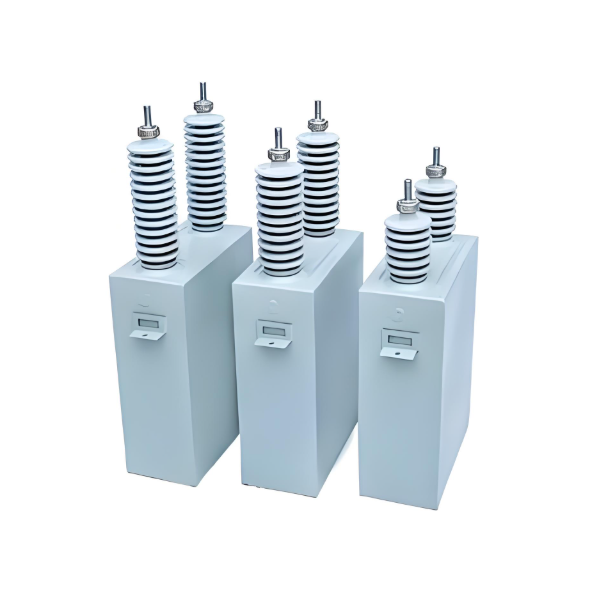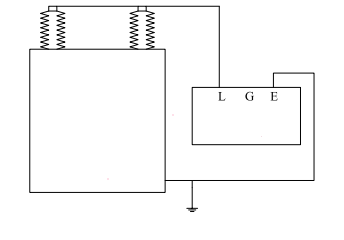
1 Mga Item sa Pagtukoy ng Diagnose pagkatapos ng Pagkabigo
1.1 Pag-identify ng mga Dahilan ng Kaguluhan at Pagtukoy ng mga Unit sa Pagsubok
Tinatawag natin ang isang rack-mounted capacitor bank bilang halimbawa, kung saan bawat individual na capacitor unit ay karaniwang may expulsion-type external fuse bilang primary protection device. Kung ang iisang capacitor ay magkakaroon ng pagkabigo, ang parallel capacitors ay magdudulot ng discharge sa pamamagitan ng fault point. Ang fuse at fusible element ng nasirang capacitor maaaring mabilis na sumira, na nag-iisolate sa bahagi ng pagkabigo upang tiyakin ang patuloy na operasyon ng bank.
Gayunpaman, kung ang mga capacitor ay magkakaroon ng open circuits o iba pang mga pagkabigo, maaari silang manatiling operational nang walang pagsira ng fuse. Kritikal na risk ng cascade: Ang maaga ang pagputol ng adjacent fuses ay nag-trigger ng chain reactions. Ang sobrang pag-disconnect ng capacitor ay nagdudulot ng imbalance na lumampas sa design limits, na sa huli ay nagdudulot ng buong pagkabigo ng fuse ng bank. Halimbawa, sa 220kV substation’s 10kV Capacitor Bank No. 2 Phase B, ang capacitor na may 14% measurement deviation ay nagsimula ng ganyang cascade, na nagdulot ng kompletong pagkabigo ng fuse ng grupo.
Kasimpulan: Kapag ang grupo ng fuse ay naputol, kailangan ng bawat capacitor na dumaan sa individual inspection at testing upang matukoy:
- Internal moisture ingress
- Component breakdown/short circuits
- Insulation degradation
Ito ay tumutukoy sa mga defective units, binabawasan ang rate ng pagkabigo, at inililipas ang mga hazard sa operasyon.
1.2 Paggamit ng Test Item sa Pagtukoy ng Kaguluhan
1.2.1 Visual Inspection
Pokus ng inspection:
- Kalinisan/luwagan ng katawan
- Oil leakage, cracks, discharge marks
- Overheating, discoloration
- Localized swelling/deformation
Ang mga isyung ito ay nagpapahiwatig ng internal structural changes, component damage, o capacitance drift na nagdudulot ng mga operational risks. Ang discoloration partikular na nangangailangan ng disassembly para sa overheating/failure analysis, na nagpapataas ng complexity ng inspection.
1.2.2 Terminal-to-Case Insulation Resistance Measurement
Layunin ng test: Matukoy ang insulation degradation mula sa moisture, deterioration, o breakdown sa pamamagitan ng pag-monitor ng pagbaba ng resistance.
Limitations: Ang test na ito ay ginagamit bilang auxiliary reference lamang kapag mayroong iba pang mga defect.
Applicability:
- ✅ Ginagawa sa dual-terminal capacitors
- ❌ Hindi kinakailangan para sa single-terminal capacitors (case acts as electrode)
Illustrated ang method ng testing sa ibaba:

1.2.3 Capacitance Measurement
Ang rack-mounted capacitor banks karaniwang gumagamit ng series-parallel configurations ng capacitor elements upang matugunan ang voltage at capacitance requirements.
- Tumataas na Capacitance: Nagpapahiwatig ng reduced series segments dahil sa internal faults (short circuit/breakdown). Ang moisture ingress (high dielectric constant of water) o blown element fuses maaari ring maging sanhi ng pagtaas ng capacitance.
- Bumabang Capacitance: Nagpapahiwatig ng reduced parallel paths mula sa open circuits, loose connections, o internal fuse operation. ⚠️ Kritikal na Risk: Ang voltage stress sa healthy elements ay tumataas, na nagpapabilis ng pagkabigo at nagbabawas ng reactive power output.
- Epekto ng Oil Leakage: Ang mas mataas na dielectric constant ng oil kaysa sa air ay nagdudulot ng measurable capacitance drift.
Diagnostic significance: Ang deviation ng capacitance ay direktang nagpapakita ng internal integrity at mahalaga para sa field troubleshooting.
Acceptance Range: ±5% to +10% ng nameplate value.
Measurement Protocol:
- Alamin ang residual charge interference
- Ulitin gamit ang multiple capacitance bridges
- Kung ang deviation ay umiiral:
- I-disconnect ang fuse links
- Alisin ang HV-side connections
- I-re-measure. Ang consistent deviation ay nagpapatunay ng internal fault.
Case Study: 110kV Substation 10kV 11A Capacitor Bank (Unit B2)
|
Parameter
|
Value
|
|
Nameplate Capacitance (Cₓ)
|
8.03 μF
|
|
Measured (Cᵧ) with HV connected
|
10.04 μF
|
|
Measured (Cᵧ) after HV disconnection
|
10.05 μF
|
|
Deviation
|
+25.16%
|
|
Kasimpulan: Ang Unit B2 ay lumampas sa tolerance limits → Nabigo.
|
|
1.3 AC Withstand Voltage Test Technique
Layunin: I-verify ang main insulation integrity (bushings/encapsulation) sa pamamagitan ng pag-apply ng AC voltage sa pagitan ng shorted terminals at case.
Test Value: Nakakadetect:
- Mababang oil levels
- Internal moisture
- Damaged bushings
- Mechanical defects
Terminal Handling:
- Short both terminals together
- Apply voltage between shorted terminals and grounded case
Industry Note: Ang routine AC withstand testing ay kadalasang hindi kinakailangan dahil sa inherent high terminal-case insulation strength ng capacitors.
2.Rational Selection of Capacitance Measurement Methods
Common Techniques:
|
Method
|
Typical Use Case
|
|
Ammeter/Voltmeter (I/V)
|
Field testing ★ Preferred
|
|
Digital Capacitance Meter
|
Field testing
|
|
Capacitance Bridge
|
Factory acceptance
|
I/V Method Superiority:
- Voltage advantage: Applied test voltage > capacitor’s operating voltage
- Detects masked faults: Activates breakdown points where:
- Failed elements retain residual insulation resistance
- Capacitance meters show false-normal readings
- Procedure: See Figure 2 (Voltage-controlled reactance testing)
|
Equipment Tag No.
|
B2
|
|
Nameplate Capacitance, Cₓ (μF)
|
8.03
|
|
Measured Cᵧ (μF) Before Disconnecting High-Voltage Lead
|
10.04
|
|
Measured Cᵧ (μF) After Disconnecting High-Voltage Lead
|
10.05
|
|
% Discrepancy (vs. Nameplate Value)
|
25.16%
|
3. Key Technical Points for Ammeter/Voltmeter Testing
3.1 Standard-Compliant Test Power Supply Waveform & Frequency
- Voltage selection: ≤5× rated voltage (based on source capacity & meter range)
- Frequency stability: Maintain steady sinusoidal waveform
- Measurement protocol:
- Stabilize voltage at rated value
- Synchronously record voltage, current, and frequency
- Calculate capacitance:
Cx=I2πfVC_x = \frac{I}{2\pi f V}Cx=2πfVI
- Critical requirements:
- Pure sine wave voltage (±3% THD limit)
- Frequency fluctuation ≤±0.5%
- Prefer line voltage (reduces 3rd harmonics)
Non-compliance risks >10% measurement error due to capacitor's XC∝1/fX_C \propto 1/fXC∝1/f characteristic.
3.2 Selection of High-Precision, Noise-Immune Instruments
- Minimum specifications:
- Accuracy class: 0.5 or better
- Electromagnetic compatibility: IEC 61000-4 compliance
- Case study - 220kV substation:
|
Instrument
|
Test Outcome
|
|
T51 AC/DC milliammeter
|
84 units show >20% deviation
|
|
T15 AC milliammeter
|
Deviation within limits
|
|
Root cause: T51 susceptibility to EMI from non-linear loads causes waveform distortion.
|
|
3.3 Controlled Voltage Ramp-Up Protocol
- Healthy capacitor response:
- Linear current rise with voltage increase
- Fault indicators:
- Current stagnation below 60V → cold solder joints
- Sudden current surge at >60V → weak insulation breakdown
Safety-critical procedure:
- Ramp voltage at ≤100 V/s rate
- Continuously monitor dIdV\frac{dI}{dV}dVdI gradient
- Abort if non-linear response detected
Rapid voltage application masks faults and risks catastrophic failure.
3.4 Safety Procedures
|
Step
|
Requirement
|
|
Pre/post-test discharge
|
Ground terminals with insulated rod (≥3×)
|
|
Safety distance
|
≥0.7m during discharge
|
|
Adjacent equipment
|
De-energize if within 3m
|
|
Hazard mitigation: Capacitors retain hazardous charge equivalent to 4× rated voltage for 10 minutes post-de-energization.
|
|
- Conclusive Guidelines
Accuracy determinants:
A[Test Accuracy] --> B[Visual Inspection]
A --> C[Power Supply Quality]
A --> D[Instrument Selection]
A --> E[Test Methodology]
A --> F[Safety Implementation]
Field-proven practices:
- Pre-test: Verify ambient EMI levels <30V/m
- During test:
- Record voltage/current waveforms (oscilloscope recommended)
- Validate linearity at 25%, 50%, 75%, 100% voltage steps
- Post-test:
- Cross-verify capacitance with 2 methods
- Trend results against historical data
Statistical finding: 68% of capacitor failures originate from moisture ingress or voltage stress - detectable through rigorous capacitance testing and IR monitoring.
Operational recommendations:
- Implement quarterly capacitance deviation trending (±3% alert threshold)
- Use IRIS(Infrared Inspection System) for thermal anomaly detection
- Maintain capacitor bank unbalance protection at <5% setting
This comprehensive protocol enhances grid reliability while reducing capacitor bank failure rates by ≥37% (per IEEE 1036 case studies).























